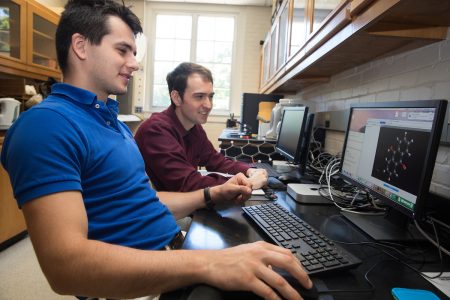Turning hydrogen peroxide green

Yuriy Snyder ’19 (left) and chemistry professor Jesse Kern test a molecule using computational modeling software
In addition to its antiseptic properties, hydrogen peroxide is used in water treatment, textile and paper bleaching, as detergent, and as an oxidizing agent. But despite its many uses, the production process can be expensive and harmful to the environment. This summer, Randolph chemistry professor Jesse Kern and Yuriy Snyder ’19 are working to find a cheaper, greener solution.
For a Summer Research project, Kern and Snyder are using computational modeling to develop a simple surface catalyst that would allow production of hydrogen peroxide directly from hydrogen and oxygen gases, without the need for catalytic nanoparticles or multiphase reactors.
“The end goals are to quantify the mechanistic pathway for each of the designed catalysts in order to conclude something about the design direction and decide what direction further designs should take us,” Kern explained. “We also want to characterize what the structure of the surface might look like.”
The project is a continuation of sorts from Kern’s research in graduate school on surface phenomena and surface structures.
“This was a direction I thought could have significant uses and could be of value to someone,” Kern said. “Obviously in a single summer we’re not going to make something that’s going to blow everyone away, but this could lead to design principles that could really help address some of the problems in the synthesis of hydrogen peroxide.”
For Snyder, who is a chemistry and physics double major, the project is exactly the kind of research experience he was looking for.
“I had been looking into opportunities in both the physics and chemistry departments, and this is the first project that’s really sparked my interest,” he said. “This is the first opportunity I’ve had to really look into an industrial process and the synthesis of something. This kind of project really aligns with my interests and is something I’m genuinely interested in.”
Tags: chemistry, Jesse Kern, student faculty research, summer research, Summer Research 2018
